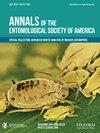Identifying Diagnostic Genetic Markers for a Cryptic Invasive Agricultural Pest: A Test Case Using the Apple Maggot Fly (Diptera: Tephritidae)
IF 3
3区 农林科学
Q1 ENTOMOLOGY
引用次数: 6
Abstract
Abstract Insect pests destroy ∼15% of all U.S. crops, resulting in losses of $15 billion annually. Thus, developing cheap, quick, and reliable methods for detecting harmful species is critical to curtail insect damage and lessen economic impact. The apple maggot fly, Rhagoletis pomonella, is a major invasive pest threatening the multibillion-dollar apple industry in the Pacific Northwest United States. The fly is also sympatric with a benign but morphologically similar and genetically closely related species, R. zephyria, which attacks noncommercial snowberry. Unambiguous species identification is essential due to a zero-infestation policy of apple maggot for fruit export. Mistaking R. zephyria for R. pomonella triggers unnecessary and costly quarantines, diverting valuable control resources. Here we develop and apply a relatively simple and cost-effective diagnostic approach using Illumina sequencing of double-digest restriction site-associated DNA markers. We identified five informative single-nucleotide polymorphisms (SNPs) and designed a diagnostic test based on agarose gel electrophoresis of restriction enzyme-digested polymerase chain reaction amplification products (RFLPs) to distinguish fly species. We demonstrated the utility of this approach for immediate, 1-d species identification by scoring apple- and snowberry-infesting flies from known hosts, reared from fruit collected at 11 sites throughout Washington. However, if immediate diagnosis is not required, or hundreds to thousands of specimens must be assessed, then a direct Illumina-based sequencing strategy, similar to that used here for diagnostic SNP identification, can be powerful and cost-effective. The genomic strategy we present is effective for R. pomonella and also transferable to many cryptic pests.一种隐性入侵农业害虫的诊断遗传标记鉴定——以苹果蛆蝇为例(双翅目:蝗科)
摘要害虫摧毁了美国约15%的作物,每年造成150亿美元的损失。因此,开发廉价、快速、可靠的有害物种检测方法对于减少昆虫危害和减轻经济影响至关重要。苹果蛆蝇Rhagoletis pomonella是一种主要的入侵害虫,威胁着美国太平洋西北部价值数十亿美元的苹果产业。这种苍蝇还与一种良性但形态相似且基因亲缘关系密切的物种——泽斑蝶(R.zephyria)有共病,后者攻击非商业性的雪浆果。由于水果出口的苹果蛆零侵扰政策,明确的物种识别至关重要。将zephyria误认为是pomonella会引发不必要且昂贵的隔离,从而转移宝贵的控制资源。在这里,我们开发并应用了一种相对简单且具有成本效益的诊断方法,使用双消化限制性位点相关DNA标记的Illumina测序。我们鉴定了五种信息性单核苷酸多态性(SNPs),并设计了一种基于限制性内切酶消化聚合酶链式反应扩增产物(RFLP)琼脂糖凝胶电泳的诊断测试来区分苍蝇物种。我们通过对来自已知宿主的苹果和雪梨寄生苍蝇进行评分,证明了这种方法在即时、一维物种识别中的实用性,这些苍蝇是从华盛顿11个地点收集的水果中饲养的。然而,如果不需要立即诊断,或者必须评估成百上千个样本,那么基于Illumina的直接测序策略,类似于这里用于诊断性SNP鉴定的策略,可以是强大且具有成本效益的。我们提出的基因组策略对绒球菌有效,也可转移到许多隐性害虫。
本文章由计算机程序翻译,如有差异,请以英文原文为准。
求助全文
约1分钟内获得全文
求助全文
来源期刊
CiteScore
4.90
自引率
0.00%
发文量
25
审稿时长
6-12 weeks
期刊介绍:
The Annals of the Entomological Society of America exists to stimulate interdisciplinary dialogue across the entomological disciplines and to advance cooperative interaction among diverse groups of entomologists. It seeks to attract and publish cutting-edge research, reviews, collections of articles on a common topic of broad interest, and discussion of topics with national or international importance. We especially welcome articles covering developing areas of research, controversial issues or debate, and topics of importance to society. Manuscripts that are primarily reports of new species, methodology, pest management, or the biology of single species generally will be referred to other journals of the ESA. The most important criteria for acceptance are quality of work and breadth of interest to the readership.

 求助内容:
求助内容: 应助结果提醒方式:
应助结果提醒方式:


